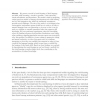1826 search results - page 75 / 366 » Using Random Forests in the Structured Language Model |
ICRA
2008
IEEE
14 years 3 months ago
2008
IEEE
— We investigate modeling and recognition of object manipulation actions for the purpose of imitation based learning in robotics. To model the process, we are using a combination...
ALIFE
2010
13 years 7 months ago
2010
We present a model of social learning of both language and skills, while assuming—insofar as possible—strict autonomy, virtual embodiment, and situatedness. This model is built...
IS
2007
13 years 8 months ago
2007
Enterprise Systems (ES) are comprehensive off-the-shelf packages that have to be configured to suit the requirements of an organization. Most ES solutions provide reference models...
EDOC
2009
IEEE
14 years 12 hour ago
2009
IEEE
Methods for enterprise architecture, such as TOGAF, acknowledge the importance of requirements engineering in the development of enterprise architectures. Modelling support is nee...
ISEM
2006
13 years 8 months ago
2006
Abstract The GXL Graph eXchange Language is an XML-based standard exchange language for sharing graph data between tools. GXL can be customized to exchange application specific typ...

